The harlequin rasbora is a small and attractive fish known for its peaceful nature and vibrant colors. These fish are an excellent choice for community aquariums, where they contribute beauty and liveliness. In this article, we will explore how to care for harlequin rasboras, including their habitat requirements, feeding, and breeding practices.
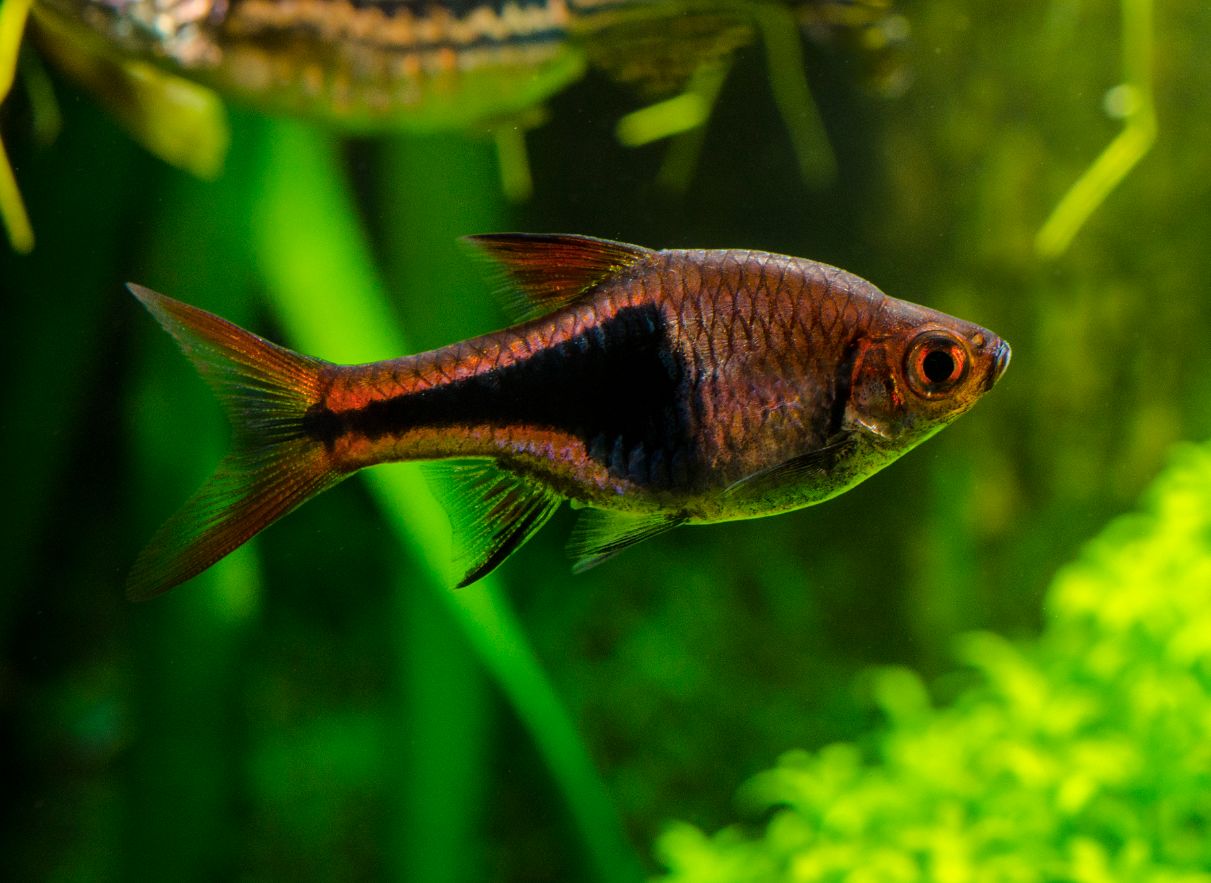
Contents
Habitat in the wild
The harlequin rasbora belongs to the family Cyprinidae, commonly known as the carp family, which is one of the largest fish families, encompassing a diverse range of freshwater species, including carp, barbs, danios, and minnows. These fish are well-regarded in the aquarium hobby for their vibrant colors and adaptability. The harlequin rasbora, in particular, is celebrated for its striking appearance and peaceful demeanor.
Native to Southeast Asia, harlequin rasboras can be found in Thailand, Malaysia, Singapore, and Indonesia’s Sumatra. In the wild, they thrive in slow-moving waters of densely vegetated areas, such as streams, rivers, and forested swamps. These habitats are characterized by low mineral content and high concentrations of dissolved humic acids, which result from water flowing through peat swamp forests.
The unique waterlogged soils in these regions inhibit the full decay of leaf litter, leading to the formation of peat that leaches humic acids into the water. Their natural environment often features sandy or muddy substrates, enriched with leaf litter and natural debris, providing ideal foraging grounds.
Harlequin rasboras prefer habitats that are richly planted with aquatic vegetation and submerged roots, which offer both shelter and security. They thrive in areas with slow to moderate water flow, as they are not particularly strong swimmers and enjoy calm environments.
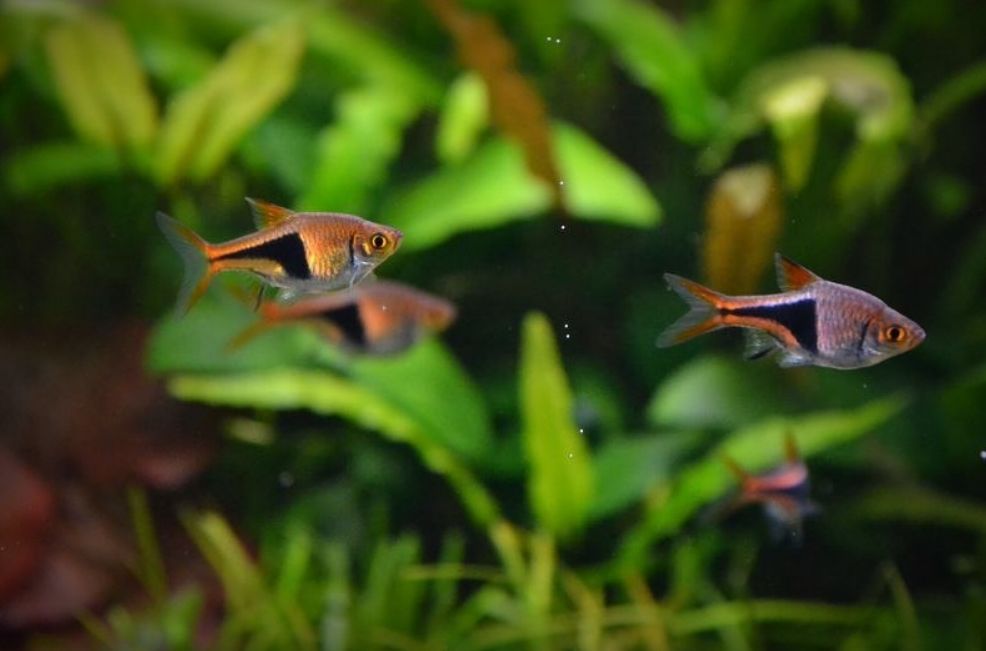
Description
Appearance
Harlequin rasboras are known for their striking appearance, featuring a streamlined, elongated body with a shimmering silver hue. Each side showcases a velvet violet triangular mark resembling a harlequin mask, extending from the middle of the body to the tail fin. Below this distinctive patch is an iridescent orange to red coloration that enhances their beauty.
Lifespan
Under optimal care, harlequin rasboras typically live for about 3 to 5 years. With excellent water quality, a balanced diet, and a stress-free environment, some individuals may live even longer.
Size
In the aquarium hobby, harlequin rasboras are relatively small, averaging 1.5 to 2 inches (3.8 to 5 cm) in length. Males and females are generally similar in size, exhibiting little sexual dimorphism. Their modest size makes them ideal for smaller aquariums, allowing them to coexist peacefully with a variety of tank mates.
| Characteristic | Description |
|---|---|
| Scientific Name | Trigonostigma heteromorpha |
| Common Name | Harlequin Rasbora |
| Family | Cyprinidae |
| Native Region | Southeast Asia (Thailand, Malaysia, Singapore, Sumatra) |
| Size | 1.5 to 2 inches (3.8 to 5 cm) |
| Lifespan | 3 to 5 years (with proper care) |
| Temperature Range | 72°F to 82°F (22°C to 28°C) |
| pH Range | 6.0 to 7.5 |
| Water Hardness | Soft to moderately hard |
| Behavior | Peaceful, shoaling species |
| Tank Size | Minimum 10 gallons (37.8 liters) for a small group |
| Tank Setup | Heavily planted with hiding spots and open swimming areas |
| Diet | Omnivorous; accepts high-quality flakes and pellets, supplemented with live/frozen foods |
| Compatibility | Peaceful community fish; avoid large/aggressive species |
| Breeding | Egg-scattering species; require a separate breeding tank with dense vegetation |
| Natural Coloration | Silver body with black triangular patch and orange-red lower body |
| Social Behavior | Should be kept in groups of at least 6 individuals |
| Natural Habitat | Slow-moving waters in heavily vegetated areas, such as streams, rivers, and forested swamps |
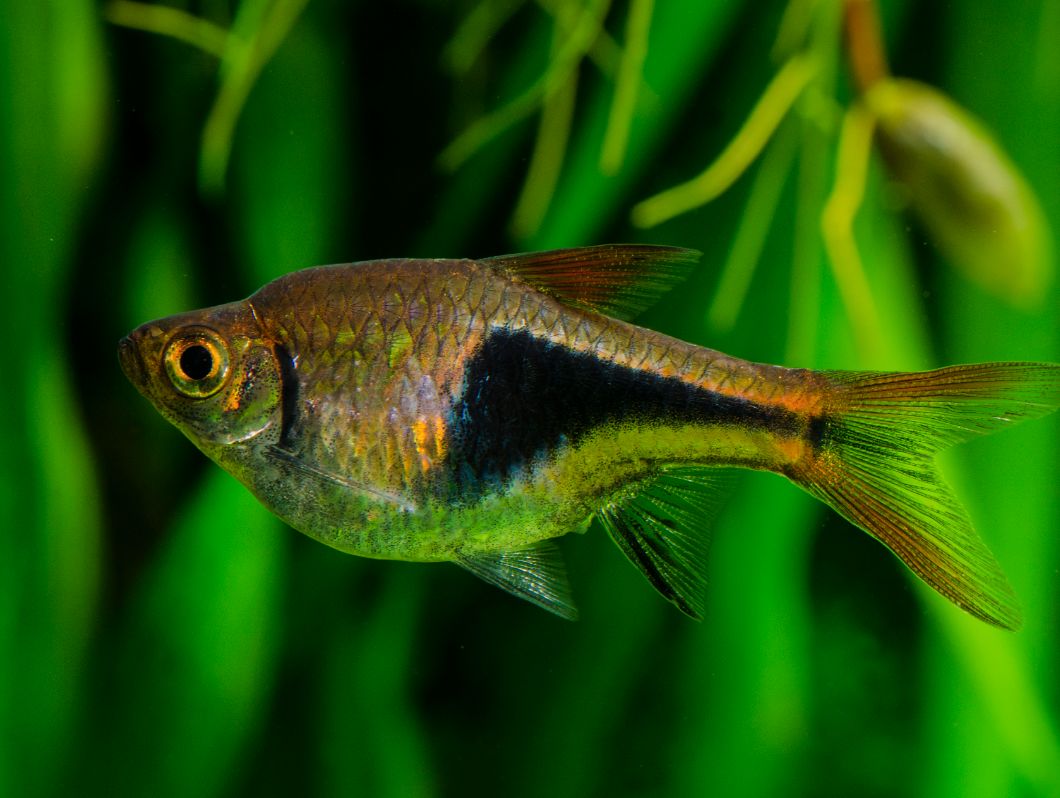
Difficulties in keeping
The harlequin rasbora is quite plane and not demanding; therefore it is very spread around the world due to its popularity among aquarists. Though the fish prefers soft and acidic water, its popularity allowed it adapt to different tank water parameters.
Care and keeping in a tank
Tank Size
Grouping Requirements
Harlequin rasboras are social and shoaling fish, thriving in groups. Keeping them in schools not only enhances their enjoyment but also benefits their well-being. A group provides a sense of security and reduces stress, leading to increased activity and vibrancy.
Minimum Tank Size
The tank size for harlequin rasboras depends on the number of fish you wish to keep and whether you want to create a community aquarium. Ideally, if you choose harlequin rasboras as the primary species, maintain a school of at least 10 fish. Each fish requires approximately 5 liters (1.32 gallons) of water for comfort. Therefore, a minimum tank size of 10 to 15 gallons (37.8 to 56.8 liters) is recommended, providing enough swimming space and allowing for proper filtration.
Dimensions
While the exact length, width, and height of the tank are less critical, a width and height of about 40-45 cm (15.75-17.72 inches) are ideal to accommodate live plants. The length should correspond to your chosen tank capacity. For larger groups or community setups with other compatible species, consider a tank of at least 20 gallons (75.7 liters) for optimal comfort.
Tank Decor
Plant Selection
It’s best to keep harlequin rasboras in planted tanks with flora primarily from Southeast Asia. Consider using several types of cryptocoryne, such as Cryptocoryne wendtii var. “Brown” and Cryptocoryne usteriana in the background and corners. For mid-ground planting, Cryptocoryne lutea works well.
Additional Elements
Including floating plants like water lettuce can enhance the fish’s comfort. A dark substrate is recommended as it enhances the fish’s appearance and reduces stress. Aim for a plant layer of about 10 cm (4 inches) thick near the back, tapering to 2-3 cm (1 inch) at the front for a pleasing perspective effect.
Water Parameters
To keep harlequin rasboras healthy, it’s essential to maintain specific water parameters that reflect their natural habitat.
- Temperature: Maintain a stable range of 72°F to 82°F (22°C to 28°C).
- pH: Slightly acidic to neutral, ideally between 6.0 to 7.5.
- Water Hardness: Aim for soft to moderately hard water, with a general hardness (GH) of 5 to 12 degrees and carbonate hardness (KH) of 2 to 10 degrees.
Toxicity Levels
Ammonia and nitrite levels should be at 0 ppm, as they are toxic to fish. Regular water changes (20-30% every 1-2 weeks) are essential to manage nitrate levels, ideally keeping them below 20 ppm.
Aeration
Ensure adequate aeration and surface movement for proper oxygen levels, although tank aeration may be less necessary due to the presence of live plants. Regular testing with a reliable kit and maintaining good tank hygiene will contribute to a healthy environment for your harlequin rasboras.
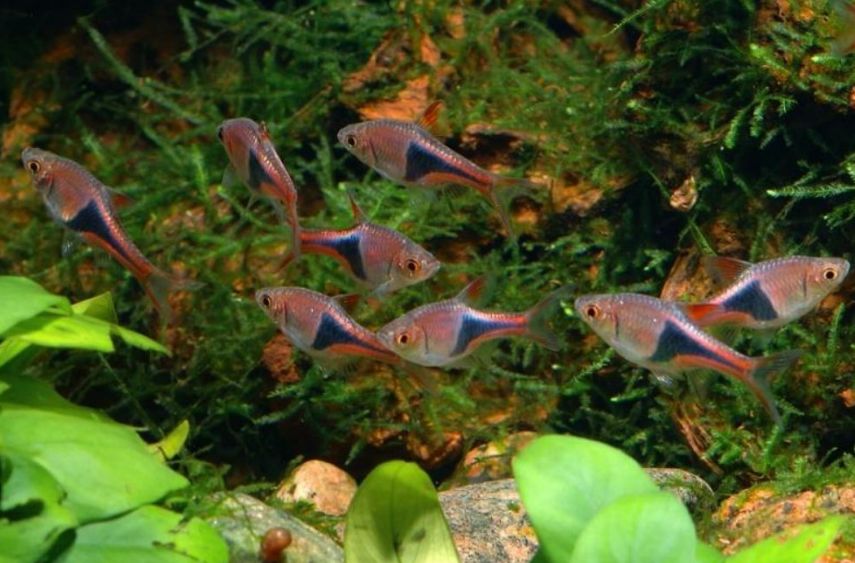
Tank mates
Harlequin rasboras are peaceful and social fish, making them excellent candidates for community aquariums. They thrive in groups and can coexist with a variety of compatible species, enhancing the overall dynamics of the tank. Due to their gentle nature, these fish can be housed with many other small, non-aggressive species.
For example:
- Neon Tetras (Paracheirodon innesi)
- Ember Tetras (Hyphessobrycon amandae)
- Glowlight Tetras (Hemigrammus erythrozonus)
- Black Neon Tetras (Hyphessobrycon herbertaxelrodi)
- Cardinal Tetras (Paracheirodon axelrodi)
- Rummy Nose Tetras (Hemigrammus rhodostomus)
- Dwarf Gouramis (Trichogaster lalius or Trichogaster chuna)
- Sparkling Gouramis (Trichopsis pumila)
- Celestial Pearl Danios (Danio margaritatus)
- White Cloud Mountain Minnows (Tanichthys albonubes)
- Dwarf Rasboras (Boraras spp.)
- Endler’s Livebearers (Poecilia wingei)
- Guppies (Poecilia reticulata)
- Platies (Xiphophorus spp.)
- Corydoras Catfish (Corydoras spp. – pygmy cory, panda cory, adolfoi catfish)
- Otocinclus Catfish (Otocinclus spp.)
- Bristlenose Plecos (Ancistrus spp.)
Compatibility Considerations
When keeping harlequin rasboras, it’s essential to avoid larger or aggressive fish that may intimidate or prey on them. Additionally, fin-nipping species can cause stress and injury, making them unsuitable tank mates.
Behavior of Juveniles
Juvenile harlequin rasboras are typically timid, preferring to stay hidden among the shadows of tank plants. As they mature, their behavior becomes more dynamic and engaging. Younger fish often swim in large schools or drift around the tank in search of food.
Social Hierarchy and Courtship
As they grow older, harlequin rasboras start to display more complex behaviors, including establishing a hierarchy within their school. Males often compete for dominance and the attention of females. This competition can be observed when males position themselves about 2 cm apart and engage in circular displays, fanning their fins and trembling slightly. While males are more commonly seen exhibiting this behavior, females can also participate, albeit less frequently.
Non-Aggressive Competitions
These displays are non-aggressive and typically do not result in injuries. Although the fish may make sudden movements, conflicts usually end in a draw, with the weaker male conceding the “field” without any harm coming to either competitor. This behavior not only highlights the social dynamics of harlequin rasboras but also provides a captivating sight for aquarists.
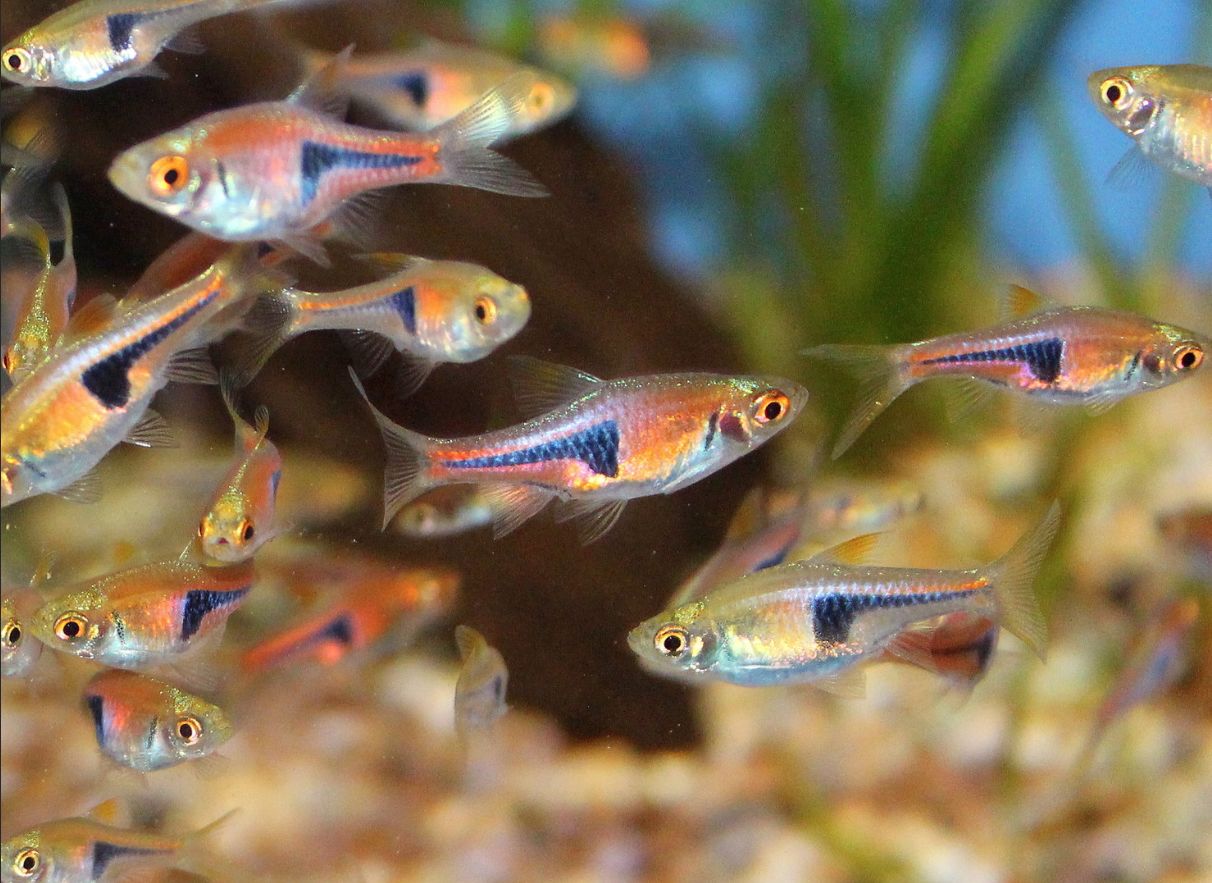
Diet
Harlequin rasboras are omnivorous, requiring a varied diet that includes both plant matter and small animal-based foods. In their natural habitat, they feed on small insects, zooplankton, algae, and detritus. To ensure their optimal health and vibrant coloration in an aquarium, it’s crucial to provide a balanced diet.
Suitable Foods
1. Staple Diet
High-quality flake or pellet food designed for tropical fish serves as the staple of their diet. Look for products that contain a balanced mix of proteins, carbohydrates, vitamins, and minerals. Specialized options like micro pellets, small granules, or crushed flakes are ideal for these small fish.
2. Supplements
To mimic their natural feeding habits, supplement their diet with live or frozen foods. Excellent choices include brine shrimp, daphnia, bloodworms, and microworms, which provide essential nutrients.
Feeding Recommendations
Feed harlequin rasboras small amounts multiple times a day rather than one large meal. This approach reflects their natural foraging behavior and helps prevent overeating or excess food wastage.
Gender differences: male vs female
Differentiating between male and female harlequin rasboras can be subtle, as they do not exhibit pronounced sexual dimorphism. However, a few characteristics can help in identifying them.
Size
Females are generally slightly larger and rounder than males, especially when they are carrying eggs. The rounded abdomen of females is a key indicator, making them easier to identify during breeding.
Coloration
Both males and females share similar color patterns, but males tend to be more vibrant and graceful in appearance. The black triangular spot on the sides of the male is sharper and more defined, while the same spot on the female is more rounded.
Behavior
During the breeding season, males often become territorial and may exhibit chasing behavior as they court females. However, it’s important to note that females can also display active participation in this process, making behavior a less definitive distinguishing factor.
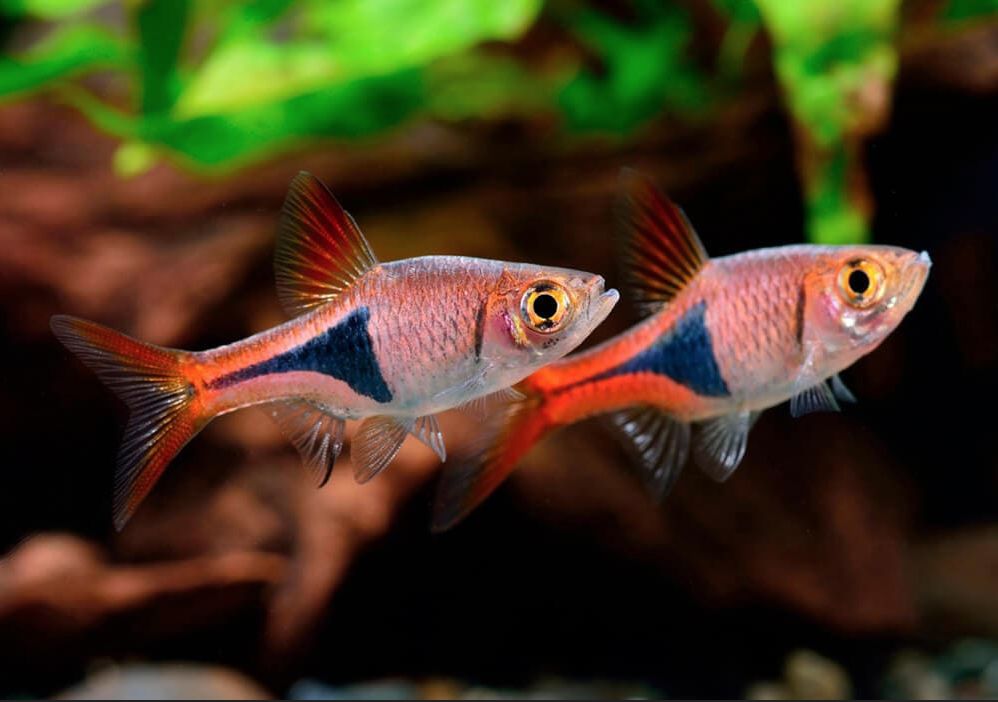
Breeding
When breeding, harlequin rasboras become particular about pair selection and environmental conditions.
Spawning Setup
To encourage breeding, use a long tank where the water depth does not exceed 20 cm (8 in). Dim lighting is essential, as bright light can stress the fish. Soft water with a temperature range of 24–28°C (75.2–82.4°F) is ideal. Suitable spawning substrates include plants like Cryptocoryne or Java fern, which can be secured to the bottom with glass sticks to create a safe and inviting environment.
Pairing the Fish
In the evening, introduce two males and three to four females into the spawning tank, which should be planted with Cryptocoryne, seedbox, or water hawthorn. The female plays a significant role in the breeding process by coaxing the male to the water’s surface. There, they embrace and turn their abdomens upward, allowing the female to attach several eggs to the undersides of the plant leaves. This nurturing behavior helps ensure the eggs are placed in a secure environment for development.
Post-Spawning Care
After the female has laid all her eggs, both the male and female should be removed from the tank to prevent them from eating the eggs. It is important to note that out of dozens of eggs, only a few will develop into juveniles. The water temperature must be maintained at approximately 28°C (82.4°F), as the eggs are extremely sensitive to temperature fluctuations, which can affect their viability.
Development of Juveniles
Approximately 1.5 days after spawning, the larvae will emerge, and they will transition into juveniles within five days. For optimal growth, feed the juveniles with cyclops nauplii and infusorians, which provide essential nutrients for their development. It’s crucial to ensure that the food size is appropriate for their small mouths, promoting healthy growth and vitality.